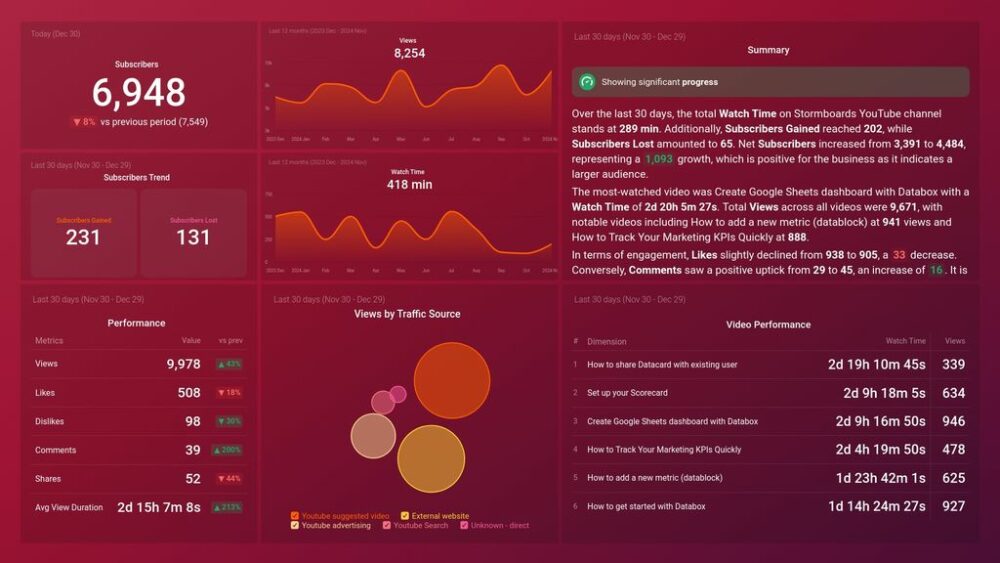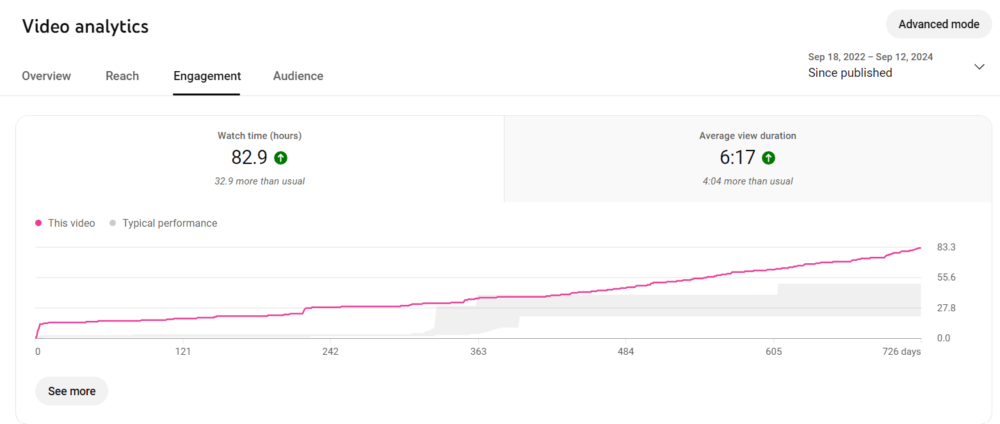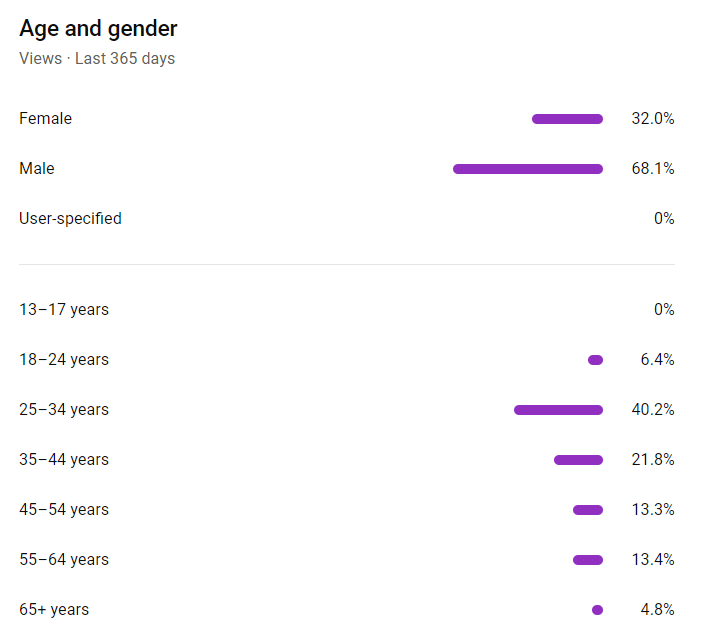Table of contents
Planning and creating engaging video content is half the battle when it comes to building a successful YouTube channel. Whether you’re managing your personal account or a business one, it requires a significant amount of work to keep things running smoothly. But how do you know whether all that hard effort is working if you don’t track progress?
Staying on top of YouTube metrics and analytics to monitor your videos’ performance is a game changer because it helps you shape your video marketing strategy and ensure it’s on the right track. However, it’s not easy to make sense of all those numbers, let alone know which ones to focus on.
So, in today’s post, we’re going to cover some of the most important metrics and KPIs on YouTube, break down what they mean, and explain how you can use them to enhance your marketing efforts just like a video marketing agency would do.
Understanding Your YouTube Video Performance: KPIs and Their Importance
You’ve probably heard about “metrics,” “analytics,” and “KPIs” many times before and seen them used interchangeably, but do you know what they actually are? What’s the difference between those terms?
To start with, “metrics” refers to the raw numbers and data points, like the specific number of views, likes, and shares. “Analytics,” on the other hand, have to do with the trends and patterns behind the metrics, like demographic or device performance insights.
Finally, KPIs (key performance indicators), in the context of YouTube, are specific metrics that help creators and marketers evaluate the success of their videos, channels, or campaigns based on their goals. In other words, they’re a measurable performance indication for a specified goal over time.
The importance of tracking KPIs lies in that they show you whether your efforts are moving in the right direction. More importantly, if they aren’t, they can tell you where to focus instead. Ultimately, they provide valuable information that helps you make informed choices, making them vital to your strategic planning process.
Pro Tip: Want to simplify tracking your channel’s KPIs? Try the YouTube Channel Performance Dashboard Template. It organizes your most important metrics in one place, helping you quickly evaluate your performance and make data-driven decisions.

How to Choose which KPIs to Focus On
There’s a wide range of YouTube KPIs to choose from, so you need to be smart and select the ones that align with your objectives. For that reason, the first step is to define your goals,and then pick the relevant KPIs.
Are you looking to grow subscribers? Then, focus on subscriber count and impressions.
Maybe you need to better engage your audience? For that, prioritizing watch time and engagement rate is the way to go.
Or, perhaps, you seek to drive traffic to a website? Pick click-through rate (CTR), conversion rate, and traffic sources.
There are as many options as there are goals, but don’t worry because I’m now going to tackle the most useful metrics to keep track of.
10 Vital YouTube KPIs to Keep an Eye On
Now, the moment we’ve all been waiting for! We’re going to break down the 10 most important YouTube key performance indicators to explain what they are and how to use them to get closer to your marketing goals. Let’s go!
1. View Count
This is one of the most straightforward metrics, as it represents the total number of times your content has been watched. A high view count means that your video is gaining traction and catching people’s attention, which is a great indicator of reach and visibility.
While a high view count might get you excited about your video’s popularity, you should always consider this metric in context and combine it with others, such as watch time and retention rate. With this, you’ll gain a more thorough understanding of whether viewers are engaging with the content, or dropping off after a few seconds. Moreover, by comparing the view count across different pieces, you’ll be able to identify the topics that entertain or resonate with your audience the most.
2. Watch Time
This metric measures the cumulative time viewers spend watching your video. Since it’s a direct reflection of how engaging a piece is, YouTube uses it to determine its value and relevance. If YouTube keeps an eye on it, you’ll definitely want to do it too!

A high watch time often correlates with strong viewer interest and relevance and it’s crucial when growing overall video or channel popularity. So, naturally, you should try to create engaging content that captures and retains audience attention as long as possible . If you have long videos, try to break them into easily-digestible segments or “episodes” to make them easier to consume.
3. Average View Duration
This YouTube KPI represents the average amount of time each viewer spends watching your video. It’s a good indicator of how compelling your content is and whether it aligns with viewer expectations.
Average view duration can help you identify areas for improvement by analyzing the drop-off points. For example, if your AVD is very low, it might indicate your introduction isn’t compelling enough or that your hook isn’t working.
4. Engagement Rate
It measures your video’s level of interaction, by focusing on how viewers actively respond to it through actions such as likes, comments, shares, and clicks. As you probably already know, high engagement usually shows not only that your content resonates with your audience but also that it sparks a connection with them.
On YouTube, 2% to 5% is considered a good engagement rate. Tracking this KPI over time helps refine your strategy by allowing you to easily identify what topics, formats, or styles your audience prefers, especially with the rise of the vertical video trend, which continues to shape content consumption habits
5. Social Shares
Shares of your video on social media are a strong signal of content value and relevance, as viewers are essentially recommending and endorsing it with their peers.
Social shares are determined by several factors, such as the emotional connection your video fosters, its informative value, creativity, visual appeal, and so on. By determining which social platforms and types of content perform best, you can optimize your distribution strategy, plan effective videos, and amplify your reach.
6. Click-Through Rate (CTR)
CTR measures the percentage of viewers who click on your call-to-action (CTA) after watching your video. This is one of the most important KPIs you’ll want to track, regardless of your marketing goals, because it helps you assess whether your video is driving the desired actions, such as subscribing to your channel, visiting your website, or signing up for a service.
Naturally, a low CTR could be pointing towards a CTA that’s not clear or persuasive enough. So, to improve YouTube CTR, you need to come with a compelling CTA and place it strategically within your video. You might need to test different placements, wording, or visuals until you find what drives the best response.
For YouTube creators, improving CTR can also help drive sign-ups for external subscription services, if they have any – adding a steady revenue stream.
7. Conversion Rate
This is a metric that reflects the percentage of viewers who complete a desired action after clicking on a call-to-action. It’s often confused with CTR, but that one only tracks the percentage of users who click on a CTA, whereas conversion rate tracks the percentage of people who actually take action
Conversion rate ties directly to your business goals and ROI, as it assesses your video’s effectiveness in turning viewers into customers, subscribers, or leads. So, you need to analyze what drives successful conversions and try to use those or similar features in future content.For example, if a certain video style results in higher conversions, consider replicating it in your next pieces.
8. Retention Rate
This YouTube KPI shows the percentage of your video that viewers watch on average. A high audience retention rate indicates that your content is engaging and valuable because most of your video is being watched. However, a low rate typically suggests that there might be issues with content relevance or even with the pacing or structure.
The key here is to identify drop-off points, that is, when viewers stop watching, and evaluate possible reasons why. This information can help you refine your script and optimize the pacing.
9. Audience Demographics
Demographics encompasses all kinds of important information about your YouTube audience, including not only age, gender, and location, but also device type, language, and more. Knowing all of this is crucial for tailoring your content to your target audience and ensuring its effectiveness, as it can lead to higher engagement and retention.

10. ROI (Return on Investment)
ROI is a KPI that measures how effective your resources (time, money, and efforts) are in generating positive outcomes, whether that’s revenue, views, engagement, or other goals. As you might imagine, it’s the ultimate indicator of video success for businesses, as it directly correlates to the value generated and tells you whether the video cost was worth the investment.
To know that for sure, you need to keep track all costs associated with content marketing, from video production to promotion, then compare them to the revenue or value generated. Then, you can use this metric to assess whether your video strategy is cost-effective.
Conclusion
Nowadays, measuring video success requires more than just tracking views! To know whether your efforts are working (or find out why they aren’t!) you need to keep an eye on the YouTube KPIs that most closely align with your goals.
By gaining deeper insights into your video’s impact and effectiveness, you can more easily refine your strategy, create effective content, and achieve your marketing goals. With the right approach, video can become one of the most powerful tools in your digital marketing arsenal!













